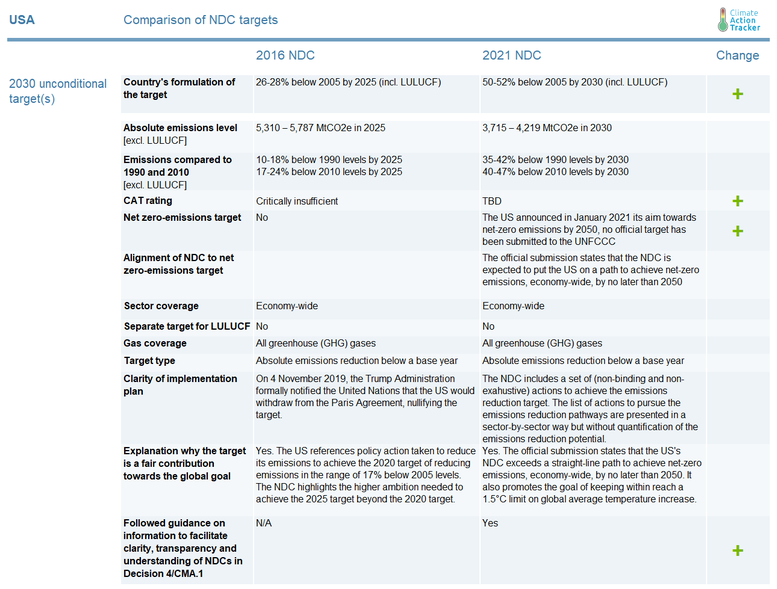Summary
Ambitious US target upgrade reduces the 2030 global emissions gap by 5-10%
The updated US government’s Paris Agreement target of 50-52% by 2030 below 2005 levels is a significant step forward, and would reduce the global emissions gap by 5-10% in 2030, the largest additional national reduction proposed in the 2020/2021 round of climate target updates.
The US target would result in 1.5-2.5 GtCO2e/yr lower emissions in 2030 below the current US trajectory. While considerably stronger than the previous US Paris Agreement target, this new US goal is still about 5% to 10% points short of a 1.5˚C compatible 2030 target, which would have been 0.4-0.9 GtCO2e/yr lower.
For the US, an emissions reduction target of 57-63% below 2005 levels by 2030 would be consistent with a 1.5°C pathway (assuming USA would in addition provide support developing countries to reduce emissions) and would put the country on a better track to achieving its 2050 net zero emissions target.
CAT analysis of NDC update

On Earth Day, 22 of April 2021 at the Leader’s Climate Summit , President Biden announced a strengthened Paris Agreement target - a Nationally Determined Contribution (NDC) of reducing emissions by 50-52% below 2005 levels by 2030, including land-use, land-use change and forestry (LULUCF). This can be translated to a reduction of 40-43% below 1990 levels.
The updated NDC represents major progress beyond the previous US target of 26-28% below 2005 levels by 2025, but is not quite enough to bring its domestic emissions in line with what would be needed to achieve the Paris Agreement’s 1.5°C limit. The CAT’s analysis indicates that the US should aim to reduce its national emissions by at least 57-63% below 2005 levels by 2030 (incl. LULUCF) and provide support to other countries in order to be consistent with the Paris Agreement 1.5°C limit and put the country on track to achieve President Biden’s stated 2050 net zero target.
The target of 50-52% would result in 1.5-2.5 GtCO2e/yr lower emissions in 2030, reducing the global 23 to 27 GtCO2e emission gap in 2030 by 5% to 10%. However, this about 5-10 percentage points short of a full 1.5˚C compatible reduction level, as it still leaves a gap of 0.4-0.9 GtCO2e/yr emissions in 2030 to a 1.5°C pathway for the US.
The CAT estimates that the 50-52% reduction target in emissions including LULUCF would translate to a range of 43-50% reduction in emissions below 2005 levels excluding LULUCF, depending on whether the sink from LULUCF is at the high or low end of the projections. The target covers emissions from all sectors and covers all greenhouse gases (GHG).
While the new target shows a rise in climate mitigation ambition, it needs to be reflected in concrete actions and policies to ensure the US meets this target. President Biden has started to act on his campaign promises and has implemented an Executive Order on Tackling the Climate Crisis at Home and Abroad to tackle GHG emissions and put the US on a path to a net-zero economy by 2050.
In late March, President Biden unveiled a USD 2 trillion infrastructure investment plan (“The American Jobs Plan”) that would accelerate climate action. Implementing this plan would be key to helping the US reach its ambitious 2030 climate target.
The infrastructure plan includes a USD 100 billion investment in the power grid and clean technologies with the goal of achieving a carbon-free electricity sector by 2035. It also calls for an investment of USD 174 billion to construct 500,000 new charging stations for electric vehicles (EVs) across the US by 2030, to electrify the federal fleet and replace at least 20% of school buses with electric models.
Other elements in the plan include investments in buildings retrofits and climate science research and innovation, as well as eliminating tax preferences for fossil fuels industries. However, it is still unclear whether the wide-ranging infrastructure bill will gain Congressional approval in its current form.
A recent CAT analysis showed that while President Biden’s goal of decarbonising the power sector by 2035 is aligned with the Paris Agreement, current plans and policies to decarbonise the US road transport sector are insufficient to reach the 1.5°C Paris Agreement temperature goal. The single most effective policy option for US transport to become 1.5˚C compatible would be a 2030 phase-out of fossil fuel light duty vehicle sales. This is the kind of ambitious policy required across all sectors for the US to meet its new 2030 NDC and its 2050 net-zero target. This has been acknowledged by the US in its NDC, with a commitment to develop further policies over time.
By 2019, total GHG emissions in the US were already 13% below 2005 levels. The US power sector was primarily responsible for this reduction, with market forces increasing the participation of cheaper renewables and gas in the energy mix, replacing dirtier coal. A full decarbonisation of the power sector by 2035, as pledged by President Biden, would alone reduce emissions by 20-25% below 2005 levels by 2030. If this plan were accompanied by ambitious electrification policies in other sectors, such as defining a 2030 target of 100% national EV sales or electrification of heating of buildings, it would put US on track to meet the new target.
States, private sector, civil society and subnational institutions have set ambitious targets and are calling for greater ambition at the federal level. The commitment showed by non-federal actors enhances the feasibility and credibility of achieving ambitious climate targets.
The announcement of an ambitious target and leadership shown by the US en route to the Leaders Summit represents a significant shift from the previous administration and sends strong signals to encourage domestic action towards decarbonised systems. It also provides a boost to international climate cooperation and could lead to the US claiming global leadership on climate action, setting tone for other countries to follow suit and adopt 2030 targets needed to make net zero a reality.
Links
Stay informed
Subscribe to our newsletter
